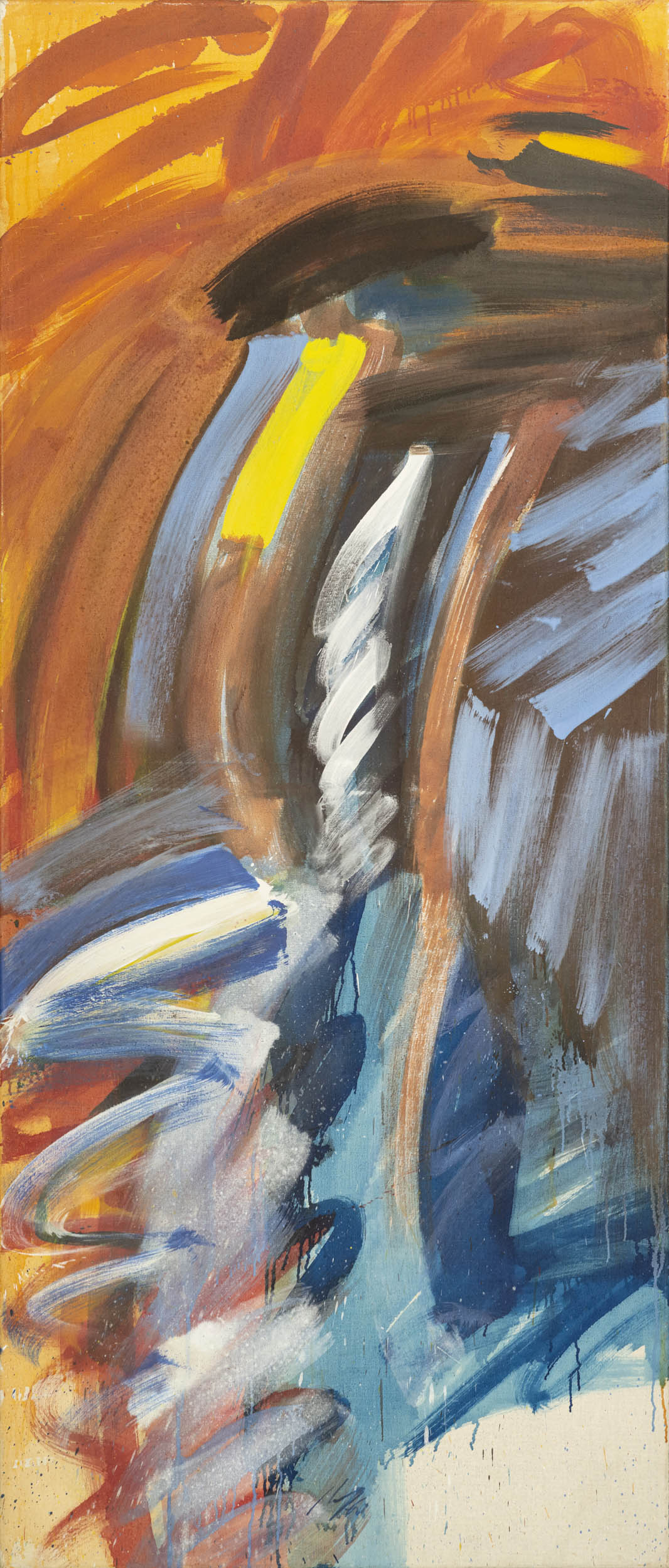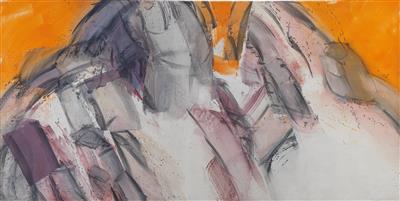(Vienna 1929–2008) “Figur auf Gelb” (Große Büste), monogrammed and dated M 71, oil on canvas, 200 x 150 cm, framed Colour illustration in: Werner Hofmann Josef Mikl Gesellschaft der Kunstfreunde Wien 9, p. 86 Provenance: Galerie Ulysses, Vienna Acquired from the above Über den Gegenstand Das, was man sieht, das, was man gesehen hat, läßt sich nicht ganz vergessen. Daher gibt es keine ausgedachten, keine wirklich gegenstandslosen Bilder. Ein Gegenstand macht das Bild erst sinnvoll. Dieser sinnvolle Inhalt deckt sich mit der Form und der Technik. Nur ein Hohlkopf kann von einem Bild behaupten, es sei ein schlechtes, aber gut gemalt oder der Erzeuger habe Vorstellungskraft ohne Form und sofort. Zwangsweise hat der Bildinhalt einen figuralen Charakter, denn in einem Zusammenhang läßt sich das, was man meint, auch mitteilen. Das Zeichnen vor der Natur unterstützt dieses gegenständliche Denken. Der Baum, das Kind, der Akt, sie verhalten sich wie Proportionsmodelle dem Zeichner gegenüber, an ihnen lernt er die Raumgrößen auf Flächen übertragen, er lernt logisch denken. Die Kunstgeschichte kennt nur logische Bilder, jedes davon ist eine Welt für sich und trotzdem unter dem Eindruck und mit der Erfahrung der Wirklichkeit gemacht; es muß allen Forderungen gerecht werden, selbst solchen, die Narren stellen: der Schulmeister, dem die Form genügt, der Oberflächliche, der nur die Technik sieht, und der Trottel, der nichts anderes als den Inhalt verlangt. Josef Mikl aus der unten angeführten Literatur About the object What one sees, what one has seen, cannot be completely forgotten. Therefore, there are no really fictitious or purely non-objective images. Only an object lends meaning to a picture. Meaningful content goes hand in hand with form and technique. Only an airhead can claim that a painting is a bad one but well painted, or that its creator has got imagination but no sense of form, and so on. A picture’s content is inevitably figural in character, for one can only express what one means in a specific context. Drawing from life supports this figurative way of thinking. A tree, a child, a nude function as proportional models for the draughtsman; they teach him how to transfer spatial volumes to flat surfaces and how to think logically. The history of art only knows logical pictures, each of which is a world of its own although it is made under the impression and based on the experience of reality; it must do justice to all demands, even those posed by fools: by the schoolmaster, for whom form suffices, by the superficial person, who only sees the technique, and by the idiot, who asks for nothing but content. Josef Mikl from the below mentioned literature
(Vienna 1929–2008) “Figur auf Gelb” (Große Büste), monogrammed and dated M 71, oil on canvas, 200 x 150 cm, framed Colour illustration in: Werner Hofmann Josef Mikl Gesellschaft der Kunstfreunde Wien 9, p. 86 Provenance: Galerie Ulysses, Vienna Acquired from the above Über den Gegenstand Das, was man sieht, das, was man gesehen hat, läßt sich nicht ganz vergessen. Daher gibt es keine ausgedachten, keine wirklich gegenstandslosen Bilder. Ein Gegenstand macht das Bild erst sinnvoll. Dieser sinnvolle Inhalt deckt sich mit der Form und der Technik. Nur ein Hohlkopf kann von einem Bild behaupten, es sei ein schlechtes, aber gut gemalt oder der Erzeuger habe Vorstellungskraft ohne Form und sofort. Zwangsweise hat der Bildinhalt einen figuralen Charakter, denn in einem Zusammenhang läßt sich das, was man meint, auch mitteilen. Das Zeichnen vor der Natur unterstützt dieses gegenständliche Denken. Der Baum, das Kind, der Akt, sie verhalten sich wie Proportionsmodelle dem Zeichner gegenüber, an ihnen lernt er die Raumgrößen auf Flächen übertragen, er lernt logisch denken. Die Kunstgeschichte kennt nur logische Bilder, jedes davon ist eine Welt für sich und trotzdem unter dem Eindruck und mit der Erfahrung der Wirklichkeit gemacht; es muß allen Forderungen gerecht werden, selbst solchen, die Narren stellen: der Schulmeister, dem die Form genügt, der Oberflächliche, der nur die Technik sieht, und der Trottel, der nichts anderes als den Inhalt verlangt. Josef Mikl aus der unten angeführten Literatur About the object What one sees, what one has seen, cannot be completely forgotten. Therefore, there are no really fictitious or purely non-objective images. Only an object lends meaning to a picture. Meaningful content goes hand in hand with form and technique. Only an airhead can claim that a painting is a bad one but well painted, or that its creator has got imagination but no sense of form, and so on. A picture’s content is inevitably figural in character, for one can only express what one means in a specific context. Drawing from life supports this figurative way of thinking. A tree, a child, a nude function as proportional models for the draughtsman; they teach him how to transfer spatial volumes to flat surfaces and how to think logically. The history of art only knows logical pictures, each of which is a world of its own although it is made under the impression and based on the experience of reality; it must do justice to all demands, even those posed by fools: by the schoolmaster, for whom form suffices, by the superficial person, who only sees the technique, and by the idiot, who asks for nothing but content. Josef Mikl from the below mentioned literature















Testen Sie LotSearch und seine Premium-Features 7 Tage - ohne Kosten!
Lassen Sie sich automatisch über neue Objekte in kommenden Auktionen benachrichtigen.
Suchauftrag anlegen